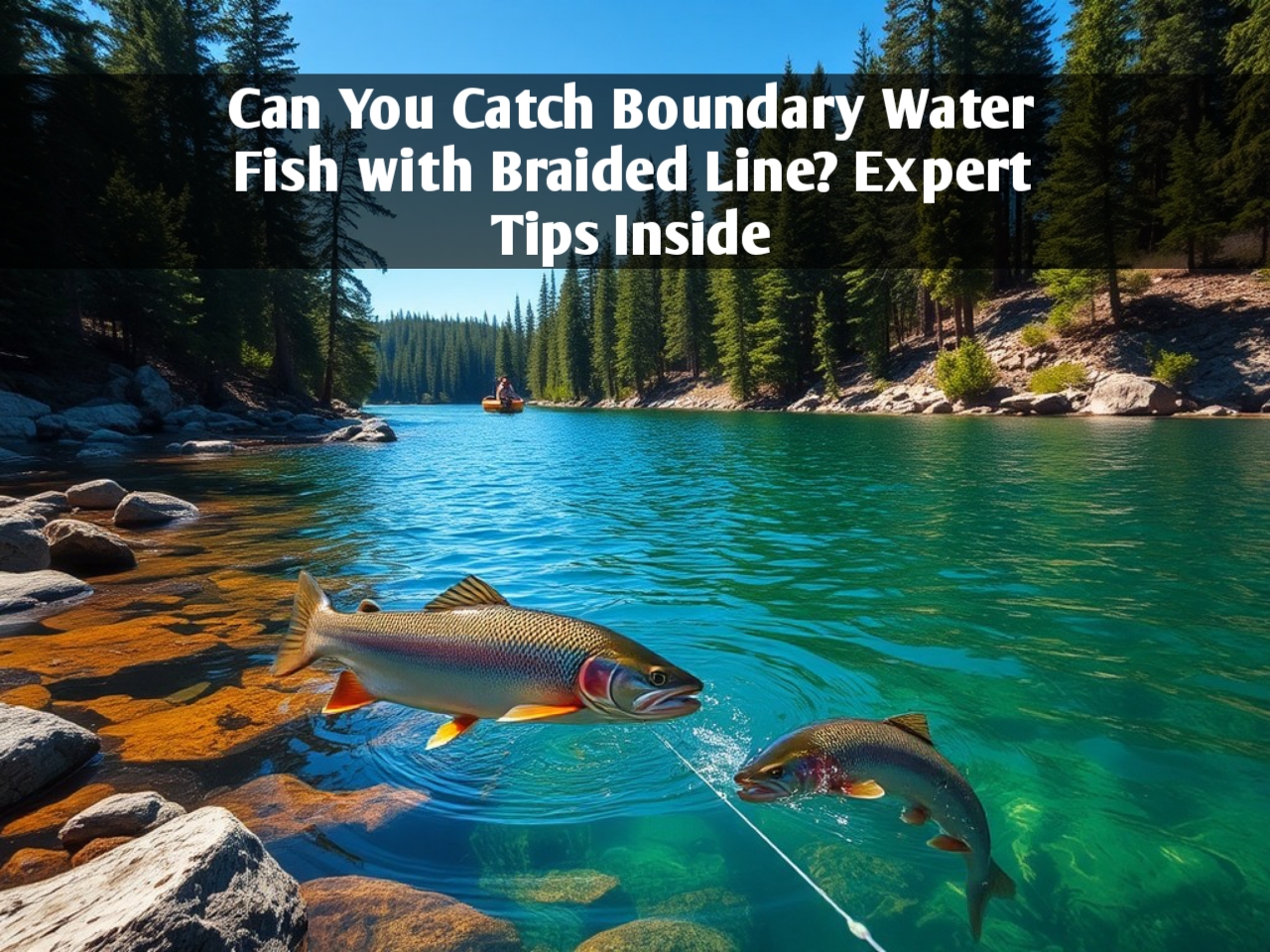Can You Catch Boundary Water Fish with Braided Line? Expert Tips Inside
Fishing in the Boundary Waters Canoe Area Wilderness (BWCAW) offers some of the most pristine and peaceful angling opportunities in North America. Surrounded by untouched natural beauty, the lakes and rivers of this region host a diverse range of fish species, including walleye, northern pike, smallmouth bass, and lake trout. For any angler planning a trip to this remote wilderness, the right gear is essential. One common question that arises, especially for those seeking an edge in these clear and sometimes shallow waters, is whether braided line is effective for catching fish in Boundary Waters. This article explores that question in detail, examining the pros and cons of braided line and offering expert tips on how to maximize your success while using it in these unique fishing environments.
What is Braided Fishing Line?
Before diving into its use in Boundary Waters, it’s important to understand what braided line is and how it differs from other types of fishing line. Braided fishing line is made by weaving together several strands of high-tech synthetic fibers, such as Dyneema or Spectra, to create a strong and thin line. This type of line has gained popularity among anglers for several reasons, particularly its strength-to-diameter ratio, durability, and sensitivity. Braided line has minimal stretch, making it highly responsive to even the slightest bites or underwater movements. Compared to traditional monofilament or fluorocarbon lines, braided line can withstand more pressure while maintaining a much thinner profile, allowing anglers to cast further and fish deeper with greater accuracy.
Benefits of Using Braided Line in Boundary Waters
Braided line offers several advantages that can help anglers increase their success when fishing in Boundary Waters. One of the key benefits is its superior sensitivity. The lack of stretch in braided line means you can feel every nibble, tap, or brush of vegetation. This is especially important in Boundary Waters, where fish can be tentative and soft-biting due to the calm, clear waters and their need to be cautious around potential predators.
Additionally, braided line’s high strength-to-diameter ratio allows you to use heavier lines without sacrificing finesse or stealth. This is crucial when targeting large, powerful fish such as northern pike or lake trout, which are abundant in Boundary Waters. A thin braided line can cut through water more efficiently than thicker monofilament or fluorocarbon lines, which can increase casting distance and improve lure action.
Another advantage of braided line in Boundary Waters is its resistance to abrasion. The lakes and rivers in this area often have rocky bottoms, submerged logs, and dense vegetation. Braided line is far more resistant to these obstacles than monofilament or fluorocarbon, meaning you’re less likely to lose a fish (or your lure) due to the line breaking on sharp rocks or underwater debris.
Challenges of Using Braided Line in Boundary Waters
While braided line offers many benefits, it also comes with some potential downsides, especially in the unique environment of Boundary Waters. One of the biggest concerns is its high visibility in clear water. Braided line is generally much more visible than monofilament or fluorocarbon, which can be a disadvantage in the clear, undisturbed waters of the BWCAW. Fish in these waters can be wary and easily spooked, and a visible fishing line could deter them from striking your lure.
Another challenge with braided line is knot slippage. Due to its slick, smooth texture, braided line can be more difficult to tie securely compared to monofilament. If you don’t use the right knots, or if they’re not tied correctly, you risk losing fish due to knot failure. Additionally, braided line can dig into itself on the spool, especially if you’re using light tackle or fighting larger fish, making it harder to cast smoothly.
Lastly, braided line has minimal stretch, which can be both a blessing and a curse. While increased sensitivity is a benefit, the lack of stretch also means there is less forgiveness when fighting a fish. You’ll need to be more careful with your drag settings and rod handling to avoid snapping the line or tearing the hook out of a fish’s mouth.
Choosing the Right Braided Line for Boundary Waters Fishing
Selecting the right braided line for Boundary Waters depends on several factors, including the species of fish you’re targeting, the specific conditions of the lake or river, and your personal fishing style. Generally, for most BWCAW fish species like walleye, smallmouth bass, and northern pike, braided line in the 10- to 30-pound test range is sufficient.
For walleye and smallmouth bass, a 10- to 15-pound test braided line works well, offering a balance of strength and finesse. If you’re fishing in particularly clear water, you may want to use a braided line with a fluorocarbon leader to reduce visibility. Fluorocarbon is nearly invisible underwater, making it an excellent choice for wary fish in clear conditions.
When targeting larger fish such as northern pike or lake trout, a 20- to 30-pound test braided line may be necessary, especially if you’re fishing around heavy cover or structure where the risk of abrasion is higher. Pike and lake trout are known for their aggressive strikes and powerful runs, so the extra strength will help you land these hard-fighting fish.
Best Knots for Braided Line in Boundary Waters
As mentioned earlier, braided line can be tricky when it comes to tying secure knots. However, there are several knots that work particularly well with braided line and are ideal for Boundary Waters fishing.
One of the most popular knots for braided line is the Palomar knot. This knot is simple to tie and maintains nearly 100% of the line’s strength, making it ideal for the strong, thin profile of braided line. Another great option is the Double Uni knot, especially if you’re using a fluorocarbon or monofilament leader. The Double Uni knot is strong and reliable, providing a seamless connection between your braided main line and your leader.
For those using a straight braided line setup without a leader, the Improved Clinch knot is another reliable option. While it can sometimes slip with braided line, applying a few extra wraps or a drop of super glue can help secure it in place.
Tips for Catching Boundary Water Fish with Braided Line
Now that you understand the basics of braided line and its pros and cons in Boundary Waters, let’s look at some expert tips for maximizing your success when using braided line in this remote fishing paradise.
- Use a Fluorocarbon Leader
One of the best ways to mitigate the high visibility of braided line in clear water is to attach a fluorocarbon leader. This gives you the strength and sensitivity of braided line while reducing the risk of spooking fish. A 2- to 4-foot fluorocarbon leader tied with a Double Uni knot is usually sufficient for most Boundary Waters fish. - Adjust Your Drag Settings
Since braided line has little to no stretch, you’ll need to rely more on your drag to absorb the shock of hard-fighting fish. Set your drag a bit looser than you would with monofilament to prevent sudden jerks from pulling the hook out or snapping the line. - Choose the Right Rod
When using braided line, it’s important to pair it with the right rod. Look for a rod with a fast or extra-fast action tip, which provides more sensitivity and allows you to detect subtle bites. A rod with a medium to medium-heavy power rating is ideal for handling the strength of braided line while still offering enough backbone to fight larger fish. - Be Mindful of Line Management
Braided line is prone to digging into itself on the spool, especially under heavy loads or during long casts. To avoid this, make sure to spool your reel tightly and evenly. If you feel the line digging in, pause your retrieve and manually pull it out before continuing to fish. - Select the Right Lures
The lack of stretch in braided line allows for better lure action, but it also means you’ll need to choose lures that complement the line’s characteristics. Crankbaits, jerkbaits, and topwater lures perform particularly well with braided line due to the direct connection they provide between the angler and the lure.
Ideal Fish Species to Target with Braided Line in Boundary Waters
Braided line is highly versatile, making it suitable for targeting a wide range of fish species in Boundary Waters. Some of the most common species you’ll encounter include:
- Walleye: Walleye are known for their finicky bites and preference for deep, cool waters. Braided line’s sensitivity helps detect light bites, while a fluorocarbon leader ensures the line remains inconspicuous in clear water.
- Smallmouth Bass: Smallmouth bass are aggressive and fight hard, making braided line an excellent choice for pulling them out of rocky or weedy areas. A 10- to 15-pound test braided line with a fluorocarbon leader works well for these fish.
- Northern Pike: Northern pike are strong, aggressive fish with sharp teeth, so a heavy braided line (20- to 30-pound test) is ideal. A wire leader is often recommended to prevent these fish from biting through the line.
- Lake Trout: Lake trout are deep-water predators that require precise presentations. Braided line’s low stretch and thin profile allow for deep jigging and long casts, making it easier to reach the depths where these fish reside.
Conclusion: Is Braided Line Effective for Boundary Water Fishing?
In conclusion, braided line can be an extremely effective tool for catching fish in Boundary Waters, provided you understand its strengths and limitations. The increased sensitivity, strength, and casting distance make it ideal for targeting a variety of species, from walleye to northern pike. However, its high visibility in clear water and potential knot issues mean you’ll need to take extra precautions, such as using a fluorocarbon leader and learning proper knot techniques.
By selecting the right braided line, pairing it with appropriate tackle, and following the expert tips outlined in this article, you can maximize your success and enjoy a rewarding fishing experience in the Boundary Waters. Whether you’re a seasoned angler or a first-time visitor to this wilderness, using braided line effectively can help you land more fish and make the most of your trip.
Read Also Our This Post: Top Fish Similar to Koi for a Calm Pond in Canada

Kamran Khatri is a versatile writer and editor at ExpressZone.co.uk, bringing fresh perspectives and insightful commentary across a wide range of topics. With a passion for exploring diverse subjects—from technology, business, and finance to lifestyle, travel, and the arts—Kamran aims to inform, inspire, and engage readers through well-researched articles and thought-provoking content.
His work spans multiple categories including health, education, pets, entertainment, real estate, and sustainability, reflecting his commitment to delivering knowledge that connects with everyday life. Whether breaking down the latest trends, sharing practical tips, or highlighting cultural insights, Kamran’s writing combines clarity with creativity.
When he’s not crafting stories for ExpressZone.co.uk, Kamran enjoys keeping up with global developments, exploring innovative ideas, and connecting with readers who share his curiosity about the world.



